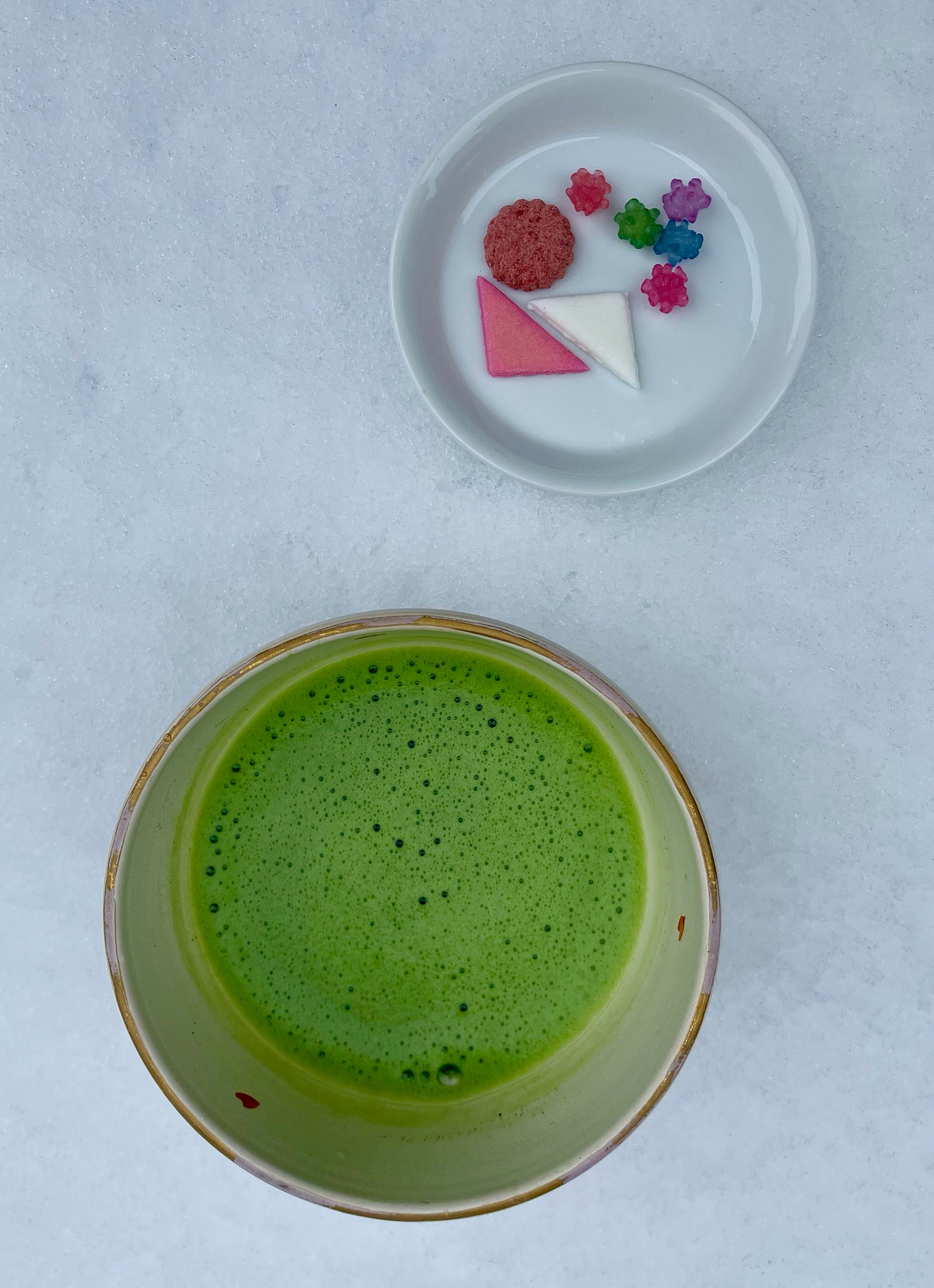ご存知の方もいらっしゃるかもしれませんが、2月6日は日本では「抹茶の日」でした。以前、Yunomiのブログ記事で日本のお茶の記念日について触れたので、今回はそれについては触れません。その代わりに、抹茶の日について深く掘り下げ、日本有数の抹茶産地である西尾市について触れたいと思います。
2月6日は「抹茶の日」です。 西尾茶業協同組合(日本語:西尾茶業協会)が1992年に西尾茶業120周年を記念して制定しました。ご存知ない方のために説明すると、愛知県西尾市は高品質の抹茶の産地として有名です。2月6日が「抹茶の日」に選ばれたのは、日本語で「2」と「6」を合わせて「風炉(ふうろ)」と発音し、茶道ではお湯を沸かすために使われる火鉢「風炉(ふうろ) 」を指します。
現在、風炉は5月から10月までの夏の茶道シーズンに使われています。しかし、茶道の本来の作法では必ず風炉が必要とされ、現在でも最上級の茶道で用いられています。前述のように、風炉とは日本の茶道で茶を点てる際にお湯を沸かすために使われる持ち運び可能な火鉢です。通常は陶器、鉄、土で作られ、上部に小さな穴が開いていて、そこにやかんや鍋を入れてお湯を沸かします。茶道の間、風炉は部屋の中央に置かれ、客の視線を釘付けにします。茶道をしていた私の祖母(今は亡き)は、家の玄関に茶道用の畳の部屋を持っていました。畳の中央に風炉があったのを覚えています。記憶が曖昧ですが、祖母が私たちに抹茶を点ててくれる時、私たちは皆、祖母と風炉の前に集まりました。祖母はここでお湯をすくって抹茶を点てていたからです。風炉は茶道に欠かせない要素であり、そのデザインと構造は茶会の場の美観と雰囲気にマッチするよう慎重に考慮されています。
 furoの画像;AC Photoより。
furoの画像;AC Photoより。
西尾茶
先ほども少し触れましたが、愛知県西尾市は抹茶の産地として有名です。 「西尾茶」とは、西尾市と隣接する安城市で生産されるお茶のことです。西尾茶として生産されるお茶の多くは、抹茶として加工されます。西尾茶の特徴は、濃い緑色の茶葉、上品な香り、そして豊かな風味です。
西尾抹茶のルーツ
南山園のある三河地方では、「西尾抹茶」は1271年に実相寺の開山聖一国師が境内に茶の木を植えたことに始まります。代々実相寺の僧侶が中国に渡り禅宗を修行し、茶と禅文化をこの地に伝えたとされています。また、江戸時代には徳川家康が西尾での茶栽培を奨励し、仁尾産の茶を朝廷への献上品として製茶するよう命じたという記録も残っています。
もう少し背景を説明すると、お茶はもともと貴族の薬として重宝されていました。そのため、西尾で茶業が盛んになる以前から、お茶の栽培が経済的な利益につながることはよく知られていました。実際、歴史的な記録には、貴重な茶樹が売買されていたことが記されています。1690年代頃には、西尾市内全域で茶樹が広く栽培されていました。
1858年に日本が開国し、海外との貿易が本格化すると、茶は生糸に次ぐ重要な輸出品目となり、国産茶への関心が急速に高まりました。西尾茶の生産が盛んになったのは、1872年(明治5年)頃、京都府宇治市から抹茶の製法が伝わったことがきっかけです。京都と静岡という二大茶産地に囲まれた西尾は、茶業を志す人々にとって大きな影響を与えました。
西尾ではお茶への熱気が高まっていたものの、京都や静岡に比べ後発だったため、これらの産地の茶業に太刀打ちできる状況ではありませんでした。そこで西尾は、玉露などの高級茶の生産に注力することで、他産地との差別化を図りました。西尾の茶商たちも研究を重ね、製茶技術を磨き上げました。しかし、こうした努力にもかかわらず、希望は見えませんでした。そこで西尾の茶愛好家たちは、当時最も市場価格が高かった碾茶の生産に注力することを決意しました。
その最大の理由は、西尾の主要貿易相手国であった尾張地方(現在の名古屋市)において、特に碾茶の需要が高かったことです。尾張地方では、尾張徳川家(特に七代宗治の時代)の影響に加え、茶道文化が庶民にも浸透していたことから、抹茶の需要が高かったのです。ちなみに、昭和6年(1931年)の『西尾茶業経済地理学』によると、尾張地方の碾茶消費量は全国全体の40%を占めていました。こうして西尾から茶業が発展し、現在の抹茶の産地へと発展していったのです。
西尾茶(にしおちゃ)は、地域ブランド抹茶の先駆けです。現在では、西尾茶は抹茶アイスクリームなどの加工食品にも広く利用されています。茶道における茶の振興だけでなく、抹茶を様々な形で楽しんでいただくことを推進する地域茶道協会です。
西尾抹茶の産地について
西尾抹茶は、愛知県南三河地方、矢作川が流れる地域で生産されています。日本の他の多くの茶産地と同様に、西尾は温暖で肥沃な土地です。特筆すべきは、矢作川が生み出す肥沃な土地と、川霧の恵みが、良質な茶の栽培に適していることです。西尾地域で栽培される茶葉の90 %以上は、抹茶の原料となる煎茶です。これは、この地域の抹茶づくりへのこだわりを表しています。
また、お茶であれば石はそれほど重要ではありませんが、抹茶となると話は別です。西尾が良質な石の産地であることは偶然ではないかもしれません。隣接する岡崎市は、抹茶を挽くのに最適な硬さときめ細やかな質感を持つ「御影石(みかげいし)」の産地です。特に京都をはじめ日本各地の抹茶臼の多くは岡崎市で生産されており、岡崎の石の品質と石工技術は日本でもトップクラスと言われています。こうした背景から、西尾は今もなお抹茶の里として輝きを放っているのです。
 葵製茶の石臼。写真提供:青井製茶
葵製茶の石臼。写真提供:青井製茶
抹茶の等級と品質
抹茶の時代を振り返ると、 Yunomiだけでなく市場全体で、お手頃価格から非常に高価なものまで、抹茶の価格帯に驚かれたことはありませんか?抹茶は産地や製造時間によって色、香り、味わいが異なり、それが等級と価格に反映されています。残念ながら、抹茶の等級を格付けする客観的な基準はなく、オンラインで販売されている抹茶製品には、実際にはほとんど飲めないほどの品質であるにもかかわらず、「セレモニーグレード」という用語が使われていることがあります。Yunomiで販売されている抹茶の等級について詳しく知りたい場合は、 「Yunomi 抹茶の等級」をご覧ください。
一般的に抹茶は、茶道などで用いられる飲用抹茶と、食品加工に用いられる抹茶に大きく分けられます。以下では、両者の主な違いをいくつかご紹介します。

ここで、日本では抹茶を儀式用の茶葉で分類していないことを指摘しておくことも重要かもしれません。実際、日本の茶道では抹茶を2つの基本的な等級に分類しています。薄茶(うすちゃ)に適した低品質の抹茶と、濃茶(こいちゃ)に適した非常に高品質の抹茶です。とはいえ、一般的に、伝統的な抹茶生産者の多くは、碾茶をこの2つのカテゴリーに分類しますが、基準は時代とともに変化しています。しかし、日本の基準では、どちらも儀式用の等級に分類されるため、少し混乱を招きます。
薄茶と濃茶の違いについて詳しくは、 「濃茶、正式な茶道の濃い抹茶について」の記事をご覧ください。
期間限定で抹茶スナックが登場
抹茶の品質について触れたところで、最後に抹茶を使ったお菓子について触れて締めくくりたいと思います。日本ではこの時期になると、スーパーやコンビニエンスストアなどで抹茶を使ったお菓子(日本語:お菓子)が数多く販売されます。中には期間限定のものもあります。例えば、森永製菓株式会社(東京)は、抹茶とスイーツの組み合わせをテーマにした期間限定のチョコレート菓子を発売しました。愛知県西尾市産の西尾抹茶を使った新作抹茶スイーツ「抹茶チーズケーキ」「抹茶ガトーショコラ」「抹茶タルト」が登場します。抹茶の日にスーパーマーケットを回った際、お菓子売り場に緑色のパッケージが溢れているのを見て驚き、思わず抹茶を使ったお菓子やチョコレートをいくつか買ってしまいました。これらのお菓子に使われている抹茶は、お菓子用に特別に作られた抹茶なので、明らかに最高級品ではありません。実際、お茶愛好家の間では、碾茶を使わずに作られたいわゆる「抹茶」が、そもそも抹茶と呼ぶ資格があるのかどうか議論されるかもしれません。さらに、そもそも料理用の抹茶(粉末茶)が「抹茶」と表示されていることも、この混乱の一因となっています。まあ、これはまた別の機会に議論しましょう!抹茶の様々な形を試してみるのは、私にとっても楽しいことだと思います。そしてこの時期に日本にいなくてもご心配なく。少なくとも今のところは、抹茶を使ったお菓子はいつでも試すことができますし、海外でも見つけられるものもあります。抹茶探検を楽しんでください!
 この時期に販売されている抹茶菓子の一部です。抹茶を飲むために産地を気にしているのですが、こうしたお菓子を買ってみて、料理における抹茶のルーツをこれまで知らなかったことに気づきました。私が買った抹茶菓子の多くには宇治抹茶に関する注意書きが付いていました。クッキーの袋の中には、初摘みの抹茶が使われていると書かれていました。
この時期に販売されている抹茶菓子の一部です。抹茶を飲むために産地を気にしているのですが、こうしたお菓子を買ってみて、料理における抹茶のルーツをこれまで知らなかったことに気づきました。私が買った抹茶菓子の多くには宇治抹茶に関する注意書きが付いていました。クッキーの袋の中には、初摘みの抹茶が使われていると書かれていました。
注目の画像:抹茶の日に東京で雪の中に抹茶を盛るという珍しい機会!
何か他にご意見やご質問がございましたら、お気軽に下記にコメントやご質問を投稿してください。または、私(Moé Kishida)まで直接ご連絡ください:moe@yunomi.life。ありがとうございます!


